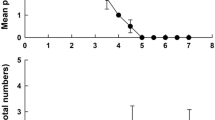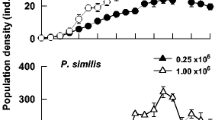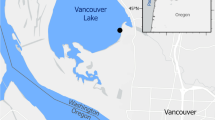Abstract
In hypertrophic waterbodies, seston may be an important food for planktonic rotifers. Therefore, we hypothesized that seston in the hypertrophic waterbody (Lake Xochimilco, State of Mexico) supports high diversity and density of rotifers. To test this, we conducted growth experiments using six rotifer species (Brachionus bidentatus, Brachionus budapestinensis, Brachionus calyciflorus, Brachionus caudatus, Brachionus havanaensis and Plationus patulus) cultured on three seston size fractions (< 3, 3–15 and < 15 µm) for 15 days. The three fractions of seston contained 3.15, 6.30, and 9.45 μg C ml−1, respectively. The physical and chemical variables of the waterbody were fairly stable during the study period. Brachionus budapestinensis, B. calyciflorus and B. caudatus showed negative growth rates when cultured on seston size of 3–15 or < 15 µm, while B. bidentatus had negative r on < 3 µm particle size. Brachionus havanaensis and P. patulus were well adapted to feed on different sizes of seston, while B. budapestinensis and B. caudatus had higher growth on < 3 µm particle size. These results explain the high diversity and density of brachionid rotifers in this waterbody where they coexist by partitioning the available seston.




Similar content being viewed by others
References
Adebayo, E. A. & D. Martínez-Carrera, 2015. Oyster mushrooms (Pleurotus) are useful for utilizing lignocellulosic biomass. African Journal of Biotechnology 14(1): 52–67.
Athibai, S. & L.-O. Sanoamuang, 2008. Effect of temperature on fecundity, life span and morphology of long- and short-spined clones of Brachionus caudatus f. apsteini (Rotifera). International Review of Hydrobiology 93(6): 690–699.
Bogdan, K. G. & J. J. Gilbert, 1982. Seasonal patterns of feeding by natural-populations of Keratella, Polyarthra, and Bosmina – clearance rates, selectivities, and contributions to community grazing. Limnology and Oceanography 27: 918–934.
Borowitzka, M. A. & L. J. Borowitzka, 1988. Micro-algal biotechnology. Cambridge University Press, London.
De Pauw, N., J. Morales & G. Persoone, 1984. Mass culture of microalgae in aquaculture systems: progress and constraints. Hydrobiologia 116: 121–134.
Declerck, S., M. Vanderstukken, S. Pals, K. Muylaert & L. De Meester, 2007. Plankton biodiversity along a gradient of productivity and its mediation by macrophytes. Ecology 88(9): 2199–2210.
DeMott, W. R., 1989. The role of competition in zooplankton succession. In Sommer, U. (ed.), Plankton ecology: succession in plankton communities. Springer, New York: 195–252.
Doohan, M., 1973. An energy budget for adult Brachionus plicatilis Muller (Rotatoria). Oecologia 13(4): 351–362.
Dumont, H. J., S. S. S. Sarma & A. J. Ali, 1995. Laboratory studies on the population dynamics of Anuraeopsis fissa (Rotifera) in relation to food density. Freshwater Biology 33: 39–46.
Ejsmont-Karabin, J., R. D. Gulati & J. Rooth, 1989. Is food availability the main factor controlling the abundance of Euchlanis dilatata lucksiana Hauer in a shallow, hypertropic lake? Hydrobiologia 186(187): 29–34.
Gayosso-Morales, M. A., S. Nandini, F. F. Martínez-Jeronimo & S. S. S. Sarma, 2017. Effect of organic and inorganic turbidity on the zooplankton community structure of a shallow waterbody in Central Mexico (Lake Xochimilco, Mexico). Journal of Environmental Biology 38(6): 1183–1196.
Gulati, R. & W. DeMott, 1997. The role of food quality for zooplankton: remarks on the state-of-the-art, perspectives and priorities. Freshwater Biology 38(3): 753–768.
Gulati, R. D., J. Rooth & J. Ejsmont-Karabin, 1987. A laboratory study of feeding and assimilation in Euchlanis dilatata lucksiana. Hydrobiologia 147: 289–296.
Jiménez-Contreras, J., S. Nandini & S. S. S. Sarma, 2018. Diversity of Rotifera (Monogononta) and egg ratio of selected taxa in the canals of Xochimilco (Mexico City). Wetlands 38: 1033–1044.
Kerfoot, W. C., W. R. DeMott & C. Levitan, 1985. Non-linearities in competitive interactions: component variables or system response. Ecology 66: 959–965.
Kirk, K. L., 1991. Inorganic particles alter competition in grazing plankton: the role of selective feeding. Ecology 72(3): 915–923.
Kirk, K. L. & J. J. Gilbert, 1990. Suspended clay and the population dynamics of planktonic rotifers and cladocerans. Ecology 71(5): 1741–1755.
Krebs, C. J., 1985. Ecology; the experimental analysis of distribution and abundance, 3rd ed. Harper & Row, New York.
Lamberti, G.A. & F.R. Hauer, 2017. Methods in Stream Ecology. In Ecosystem Function, Vol. 2, 3rd edn, Elsevier, London.
Lucía-Pavón, E., S. S. S. Sarma & S. Nandini, 2001. Effect of different densities of live and dead Chlorella vulgaris on the population growth of rotifers Brachionus calyciflorus and Brachionus patulus (Rotifera). Revista de Biología Tropical 49(3–4): 895–902.
Miracle, M. R., E. Vicente, S. S. S. Sarma & S. Nandini, 2014. Planktonic rotifer feeding in hypertrophic conditions. International Review of Hydrobiology 99: 141–150.
Müller-Navarra, D. C., M. T. Brett, S. Park, S. Chandra, A. P. Ballantyne, E. Zorita & C. R. Goldman, 2004. Unsaturated fatty acid content in seston and tropho-dynamic coupling in lakes. Nature 427: 69–72.
Nandini, S., P. Ramírez-García & S. S. S. Sarma, 2005. Seasonal variations in the species diversity of planktonic rotifers in Lake Xochimilco, Mexico. Journal of Freshwater Ecology 20(2): 287–294.
Nandini, S., S. S. S. Sarma, R. J. Amador-López & S. Bolaños-Muñoz, 2007. Population growth and body size in five rotifer species in response to variable food concentration. Journal of Freshwater Ecology 22: 1–10.
Nandini, S., P. Ramírez-García & S. S. S. Sarma, 2016. Water quality indicators in Lake Xochimilco, Mexico: zooplankton and Vibrio cholera. Journal of Limnology 75(1): 91–100.
Onandia, G., J. D. Dias & M. R. Miracle, 2015. Zooplankton grazing on natural algae and bacteria under hypertrophic conditions. Limnetica 34(2): 541–560.
Ooms-Wilms, A. L., 1997. Are bacteria an important food source for rotifers in eutrophic lakes? Journal of Plankton Research 19(8): 1125–1141.
Pavón-Meza, E. L., S. S. S. Sarma & S. Nandini, 2004. Combined effects of food (Chlorella vulgaris) concentration and temperature on the population growth of Brachionus havanaensis (Rotifera: Brachionidae). Journal of Freshwater Ecology 19(4): 521–530.
Pilarska, J., 1977. Eco-physiological studies on Brachionus rubens Ehrbg. (Rotatoria). III. Energy balances. Polskie Archiwum Hydrobiologii 24: 343–354.
Pourriot, R., 1965. Recherches sur l’écologie des Rotifères. Publications du laboratoire Arago. Volume 4349. Thèses présentées à la Faculté des Sciences de l’Université de Paris, Paris.
Regali-Seleghim, M. H. & M. J. L. Godinho, 2004. Peritrich epibiont protozoans in the zooplankton of a subtropical shallow aquatic ecosystem (Monjolinho Reservoir, São Carlos, Brazil). Journal of Plankton Research 26(5): 501–508.
Sarma, S. S. S., 1991. Rotifers and aquaculture (review). Environment and Ecology 9: 414–428.
Sarma, S. S. S., P. S. Larios-Jurado & S. Nandini, 2001. Effect of three food types on the population growth of Brachionus calyciflorus and Brachionus patulus (Rotifera: Brachionidae). Revista de Biología Tropical 49(1): 75–82.
Sarma, S. S. S., A. E. Fuentes-Barradas, S. Nandini & D. J. Chaparro-Herrera, 2017. Feeding behaviour of larval Ambystoma granulosum (Amphibia: Caudata). Journal of Environmental Biology 38(6): 1241–1248.
Sarma, S. S. S., J. A. Guevara-Franco, B. Almaraz-Ornelas & S. Nandini, 2018. Interspecific effects of allelochemicals of 4-species of Brachionidae (Rotifera: Monogononta) on the population growth. Allelopathy Journal 45(2): 277–290.
Starkweather, P. L., J. J. Gilbert & T. M. Frost, 1979. Bacterial feeding by the rotifer Brachionus calyciflorus: clearance and ingestion rates, behavior and population dynamics. Oecologia 44(1): 26–30.
Stephan-Otto, E., 2003. El Agua en la Cuenca de México. Sus problemas históricos y perspectivas de solución. Proceedings of the Second International Conference on Xochimilco, Vol. 1. Ecological Park of Xochimilco, Mexico City, Mexico.
Wallace, R. L. & T. W. Snell, 2010. Rotifera. In Thorp, J. & A. Covich (eds), Ecology and Classifications of North American Freshwater Invertebrates, 3rd ed. Elsevier, Oxford: 173–235.
Wilms, A. L., R. D. Gulati & G. Postema, 1991. First attempt to measure the clearance rate of Anuraeopsis fissa. Verhandlungen Internationale Vereinigung für theoretische und angewandte Limnologie 24: 742–744.
Yoshinaga, T., A. Hagiwara & K. Tsukamoto, 2001. Why do rotifer populations present a typical sigmoid growth curve? Hydrobiologia 446(447): 99–105.
Acknowledgements
Three anonymous reviewers and handling editor(s) have greatly improved our presentation. We also thank DGAPA—PAPIIT (IN214618 & IN219218) for financial support.
Author information
Authors and Affiliations
Corresponding author
Additional information
Guest editors: Steven A. J. Declerck, Diego Fontaneto, Rick Hochberg & Terry W. Snell / Crossing Disciplinary Borders in Rotifer Research
Rights and permissions
About this article
Cite this article
Sarma, S.S.S., Nandini, S. Comparative population dynamics of six brachionid rotifers (Rotifera) fed seston from a hypertrophic, high altitude shallow waterbody from Mexico. Hydrobiologia 844, 55–65 (2019). https://doi.org/10.1007/s10750-018-3875-6
Received:
Revised:
Accepted:
Published:
Issue Date:
DOI: https://doi.org/10.1007/s10750-018-3875-6




